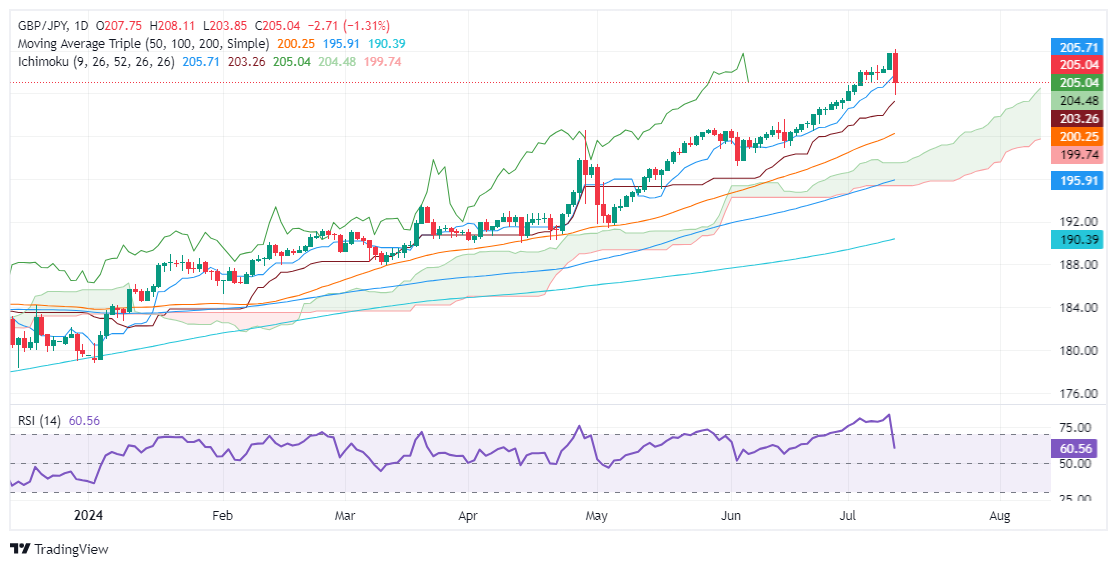GBP/JPY Price Analysis: Plunges amid intervention fears, hoovers around 205.00

- GBP/JPY experiences volatility, peaking at 208.11, then dips to 203.82, settling at 204.99.
- Downward momentum observed; support at 203.25 (Kijun-Sen) and 200.16 (50-DMA).
- Resistance positioned at 205.00 and 205.64 (Tenkan-Sen); breach could signal recovery.
The Pound-Yen pair witnessed a volatile session amid speculation of Japanese authorities’ intervention after the latest US inflation report announcement. The GBP/JPY traveled 425 pips in the session, hitting a high of 208.11 before plummeting toward 203.82. Since then, the cross stabilized at around the 204.99 mark, sustaining more than 1.20% losses.
GBP/JPY Price Analysis: Technical outlook
The GBP/JPY daily chart shows the pair as upward biased, even though it cleared the Tenkan-Sen level at 205.64, which accelerated the pair’s fall underneath the Senkou Span A at 204.45. Nevertheless, it has recovered some ground, though in the near term, momentum supports sellers.
The Relative Strength Index (RSI) remains bullish but shows a steeper slope to the downside at the time of writing, hinting that bears loom.
In a bearish continuation, sellers must push the prices below the abovementioned Senkou Span A, which could pave the way to test the Kijun-Sen at 203.25. A further downside is seen at the 50-day moving average (DMA) at 200.16, ahead of the Senkou Span B at 199.3.
Conversely, if GBP/JPY recovers some ground and clears 205.00, further gains lie ahead. The cross could aim towards the Tenkan-Sen at 205.64 before challenging 206.00.
GBP/JPY Price Action – Daily Chart
Pound Sterling FAQs
The Pound Sterling (GBP) is the oldest currency in the world (886 AD) and the official currency of the United Kingdom. It is the fourth most traded unit for foreign exchange (FX) in the world, accounting for 12% of all transactions, averaging $630 billion a day, according to 2022 data. Its key trading pairs are GBP/USD, aka ‘Cable’, which accounts for 11% of FX, GBP/JPY, or the ‘Dragon’ as it is known by traders (3%), and EUR/GBP (2%). The Pound Sterling is issued by the Bank of England (BoE).
The single most important factor influencing the value of the Pound Sterling is monetary policy decided by the Bank of England. The BoE bases its decisions on whether it has achieved its primary goal of “price stability” – a steady inflation rate of around 2%. Its primary tool for achieving this is the adjustment of interest rates. When inflation is too high, the BoE will try to rein it in by raising interest rates, making it more expensive for people and businesses to access credit. This is generally positive for GBP, as higher interest rates make the UK a more attractive place for global investors to park their money. When inflation falls too low it is a sign economic growth is slowing. In this scenario, the BoE will consider lowering interest rates to cheapen credit so businesses will borrow more to invest in growth-generating projects.
Data releases gauge the health of the economy and can impact the value of the Pound Sterling. Indicators such as GDP, Manufacturing and Services PMIs, and employment can all influence the direction of the GBP. A strong economy is good for Sterling. Not only does it attract more foreign investment but it may encourage the BoE to put up interest rates, which will directly strengthen GBP. Otherwise, if economic data is weak, the Pound Sterling is likely to fall.
Another significant data release for the Pound Sterling is the Trade Balance. This indicator measures the difference between what a country earns from its exports and what it spends on imports over a given period. If a country produces highly sought-after exports, its currency will benefit purely from the extra demand created from foreign buyers seeking to purchase these goods. Therefore, a positive net Trade Balance strengthens a currency and vice versa for a negative balance.
